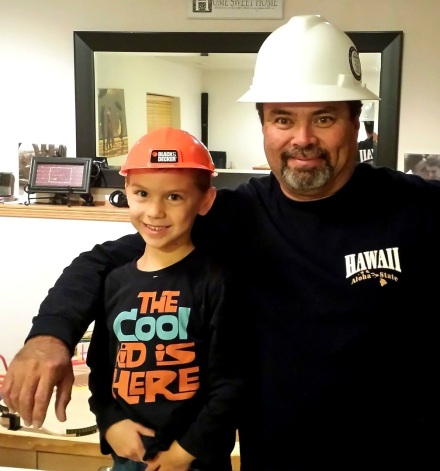Many parents would just love it if their children were to listen to what they say, and not imitate their behavior instead.
But the reality is that although informational learning can be influential, we (including children) also modify our behavior by observing and imitating others.
Observational learning, also known as vicarious learning, or modeling, refers to a kind of learning that results from observing a behavior and the consequences of it.
Imagine a child going up to his father and requesting a much larger allowance than he has been receiving. The authoritarian father reacts to this request by slapping the boy hard across the face. The boy, his lips bleeding and his eyes full of tears, lets out a wail and runs out of the room.
Unknown to both, however, the boy’s younger brother had been watching the whole interaction from the far corner of the room.
What do you think is going on in the mind of the younger boy? Having witnessed the severe consequences of his brother’s request, the younger boy might have learned to fear asking his father for increased allowance—or perhaps anything at all.
Like this example, in vicarious learning we observe how our relatives, friends, classmates, coworkers, even famous athletes or actors behave. And we pay attention to the consequences of their behaviors.
And children often imitate their parents. Copying parents’ actions can sometimes be a good thing. The little girl in the featured image for this article might has become interested in exercising by copying her parent. But vicarious learning may not be a good thing when, for example, we end up learning those same irrational fears that our parents have been unable to overcome.

Experimental evidence for vicarious learning
Let us consider a study of observational learning in detail.1 This is how the experiment was conducted:
Two participants would watch a series of pictures while their physiological reactions were being recorded using electrodes. At some point, as planned, the experimenter would interrupt the experiment, claiming that the readings from one of the participants (the “model”), when she had been exposed to pictures of certain stimuli, were unusually high.
In one condition, these stimuli were threat-relevant (e.g., snakes), and in another condition, they were threat-irrelevant (e.g., flowers).
The model, who was in reality a research associate and was merely acting, would then go on to explain her phobia of that particular stimulus quite vividly.
The researchers found that the participants, after having witnessed this interaction (and a couple of subsequent ones), learned to fear both the fear relevant and fear-irrelevant stimuli—though the learned fear of the threatening stimuli was much more robust.
Another demonstration of vicarious learning comes from a famous series of studies on rhesus monkeys. In these studies, rhesus monkeys that were reared in laboratory were shown videos of monkeys in the wild reacting fearfully to snakes. As a result, these lab-reared monkeys developed intense fear of snakes; their fears were present even at the three-month follow-up.2
Research on vicarious learning of common fears
I will now briefly review some findings on the role of observational learning in development of common fears (e.g., fear of heights, snakes, injuries, etc).
In a study of over 1,000 children from US and Australia, roughly 40-70% of the highly fearful participants reported the influence of vicarious learning experiences.3
In an investigation of undergraduates who had a fear of heights, 20% considered vicarious learning causal in the genesis of their fears; this percentage was similar to that of classical conditioning pathway.4
In research on fear of blood, injections, and injuries, in a sample of 128 university students, close to 20% of those who could recall fear-related experiences considered modeling to have been the main pathway of fear acquisition; but about 75% reported to have acquired their fears via classical conditioning.5
Conclusion
It appears that when a person has plenty of opportunities to experience a fear directly, modeling may play a smaller role in explaining the genesis of the fear.
For instance, in the study involving American and Australian children noted earlier, more children reported the influence of modeling (over classical conditioning) for fear of burglar break-ins; but the opposite was true for fear of suffocation.3
This is not surprising, given that most children have experienced struggling for breath one time or another, but not many have encountered burglar break-ins.
Vicarious learning may be more effective in explaining those fears that are either abstract (fear of the unknown or death) or related to rare events (such as war).
Generally speaking, children (and those people with limited experiences) are more likely to learn fears by observing others.
The good news, of course, is that we may also learn positive behavior from observing others. We can learn how to act courageously, for instance. We can learn that despite our limitations and the restrictions of the world around us, impossible can become possible.
And as adults, we have more freedom to follow those people, be they friends or celebrities, who have a positive effect on us.
Note: This post is based in part on a much longer article which I wrote for the Inquisitive Mind magazine (editor-in-chief: Matthew Baldwin, PhD, University of Cologne). That article is freely available online here: http://www.in-mind.org/article/origins-of-common-fears-a-review
References
1. Hygge, S., & Öhman, A. (1978). Modeling processes in acquisition of fears: Vicarious electrodermal conditioning to fear-relevant stimuli. Journal of Personality and Social
Psychology, 36, 271–279.
2. Mineka, S., Davidson, M., Cook, M., & Keir, R. (1984). Observational conditioning of snake fears in rhesus monkeys. Journal of Abnormal Psychology, 93, 355–372.
3. Ollendick, T. H., & King, N. J. (1991). Origins of childhood fears: An evaluation of Rachman’s theory of fear acquisition. Behaviour Research & Therapy, 29, 117-123.
4. Menzies, R. G., & Clarke, J. C. (1993). The etiology of fear of heights and its relationship to severity and individual response patterns. Behaviour Research and Therapy, 31, 355–365.
5. Kleinknecht, R. A. (1994). Acquisition of blood, injury, and needle fears and phobias. Behaviour Research and Therapy, 32, 817−823.

Just keep focused upon the your goal and keep writing good
informative articles. This list becomes your most treasured
possession in internet marketing. Keep track of your comments from
customers. http://www.badmoon-racing.jp/frame/?url=http://918kiss.bid/downloads/78-download-918kiss-casino-games-all-in-one-ios-and-android
LikeLike
I absolutely love your blog and find many of your post’s to be what precisely I’m
looking for. Would you offer guest writers to write content for you?
I wouldn’t mind writing a post or elaborating on many of
the subjects you write concerning here. Again, awesome site! https://kasino.vin/downloads/67-download-joker123
LikeLike
Excellent items from you, man. I have take into accout your
stuff prior to and you’re just too excellent. I really like what you have got
here, really like what you are stating and the way in which
wherein you say it. You are making it enjoyable and you still take care of to stay it smart.
I can not wait to learn much more from you. This is actually a terrific web site.
LikeLike